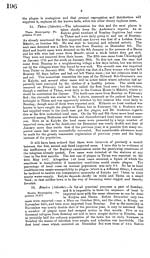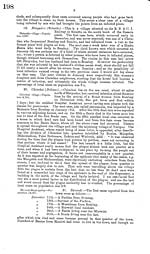Medicine - Disease > Account of plague administration in the Bombay Presidency from September 1896 till May 1897
(211) Page 197
Download files
Individual page:
Thumbnail gallery: Grid view | List view

7
Christians who are reported to have been in daily communication with Bombay
and may have become infected there; but Doctor Anderson's remark in the
case of one of them, a toddy-drawer, that rats had died in the house a week
previously, may indicate that there had been an infected visitor and perhaps
an unreported case either in this or some adjacent house previously. Four
other cases occurred in this house. Then another toddy-drawer, who had been
about the infected house, got the plague, then the people of the adjoining house,
and presently those of other houses in the vicinity. This was a clear case of
plague spreading from house to house in the absence of segregation. The next
group of houses attacked was also inhabited by Christians. These were all in
Bndra proper, which is nearest to Bombay. The Pli quarter, which comes
next going northwards, was infected at the beginning of January, the Chuim
quarter, which lies beyond, at the beginning of February, and Dnda, which lies
still further north, about the middle of that month. Thus there was a regular
progression of the disease in the direction from Bombay. A curious circumstance
about this progression is that the death of rats is usually recorded as preceding
the first recorded cases in each place. The natural presumption that concealed
cases had occurred in each quarter, whereby the rats were infected, is rebutted
by the fact ascertained by me from the Vice-President that the excess mortality
of November-January described by Doctor Anderson was confined to Bndra
proper. It seems clear therefore that Pli, Chuim and Dnda had no plague till
the rats brought it, and that here we have a "Rat's Progress" from south to north
through the successive quarters of the town, infecting one after the other. The
exodus apparently went beyond Dnela to Snta Cruz, where rats died in the middle
of February, and to Ju and Tra villages about 2 miles north of Dnda, where rats
began to die early in April. The percentage of local cases on normal popula-
tion in this town was 4.7. Bndra has an excellent and plentiful water-supply
from the Bombay main, and (without being able to make any great boast) is
probably on the whole the most sanitary town in the district. It suffered,
however, more heavily than any other municipality in the district as will be
seen by referring to the list in paragraph 69 below.
Kurla Municipality-Popu-
lation 11,469.
17. Kurla (Slsette).-This town is like Bndra practically a suburb of
Bombay, to which a large part of the population
habitually resort for business, and it became the home
of two or three thousand refugees. The first reported
case which occurred on December 5th was that of a local resident, but he had
contracted the disease while attending the funeral of a relative in Bombay on
December 2nd. The next case was that of a cart-driver who went daily to Bombay.
The third, fourth and fifth reported cases between December 23rd and 28th were
all of persons who came with the plague from Bombay; but as Doctor Anderson
has pointed out the mortality returns for December, when compared with those
of the previous year, imply a very considerable number of concealed cases. The
fact clearly is that at first in Kurla as in Bndra, and to some extent Thna
practically, only those cases were reported which it was impossible or no one's
interest to conceal. Consequently the imported cases recorded are rather
evidence that importation was going on than evidence of how importation
produced local cases. We probably do not know of all the imported cases and
of half the local cases which first occurred, and therefore there are gaps in the
sequences of the latter on the former. In Kalyn where vigilance was hawk-eyed
from the first and few, if any, cases escaped notice, the sequence is clearly
established. The first reported case among the local residents of infection
probably contracted in Kurla itself occurred on January 1st in a chawl of mill-
hands and after that the local cases became too numerous for general conceal-
ment. Kurla is a very dirty town, but the percentage of local cases on
population was only 3.7 per cent.
18. Close to Kurla, and part of same Municipality but separated by a dis-
tance of about a quarter of a mile, is Old Kurla, a Christian village. The inhabit-
ants of this quarter combined to exclude all residents of the infected quarter
and had such success that their village almost escaped the plague. Early in
April, however, some rats died in a house at the end of the village nearest to New
Kurla; and on the 8th two cases of plague occurred, though not in that house.
The people then moved in a mass into sheds; but two more cases occurred in the
Christians who are reported to have been in daily communication with Bombay
and may have become infected there; but Doctor Anderson's remark in the
case of one of them, a toddy-drawer, that rats had died in the house a week
previously, may indicate that there had been an infected visitor and perhaps
an unreported case either in this or some adjacent house previously. Four
other cases occurred in this house. Then another toddy-drawer, who had been
about the infected house, got the plague, then the people of the adjoining house,
and presently those of other houses in the vicinity. This was a clear case of
plague spreading from house to house in the absence of segregation. The next
group of houses attacked was also inhabited by Christians. These were all in
Bndra proper, which is nearest to Bombay. The Pli quarter, which comes
next going northwards, was infected at the beginning of January, the Chuim
quarter, which lies beyond, at the beginning of February, and Dnda, which lies
still further north, about the middle of that month. Thus there was a regular
progression of the disease in the direction from Bombay. A curious circumstance
about this progression is that the death of rats is usually recorded as preceding
the first recorded cases in each place. The natural presumption that concealed
cases had occurred in each quarter, whereby the rats were infected, is rebutted
by the fact ascertained by me from the Vice-President that the excess mortality
of November-January described by Doctor Anderson was confined to Bndra
proper. It seems clear therefore that Pli, Chuim and Dnda had no plague till
the rats brought it, and that here we have a "Rat's Progress" from south to north
through the successive quarters of the town, infecting one after the other. The
exodus apparently went beyond Dnela to Snta Cruz, where rats died in the middle
of February, and to Ju and Tra villages about 2 miles north of Dnda, where rats
began to die early in April. The percentage of local cases on normal popula-
tion in this town was 4.7. Bndra has an excellent and plentiful water-supply
from the Bombay main, and (without being able to make any great boast) is
probably on the whole the most sanitary town in the district. It suffered,
however, more heavily than any other municipality in the district as will be
seen by referring to the list in paragraph 69 below.
Kurla Municipality-Popu-
lation 11,469.
17. Kurla (Slsette).-This town is like Bndra practically a suburb of
Bombay, to which a large part of the population
habitually resort for business, and it became the home
of two or three thousand refugees. The first reported
case which occurred on December 5th was that of a local resident, but he had
contracted the disease while attending the funeral of a relative in Bombay on
December 2nd. The next case was that of a cart-driver who went daily to Bombay.
The third, fourth and fifth reported cases between December 23rd and 28th were
all of persons who came with the plague from Bombay; but as Doctor Anderson
has pointed out the mortality returns for December, when compared with those
of the previous year, imply a very considerable number of concealed cases. The
fact clearly is that at first in Kurla as in Bndra, and to some extent Thna
practically, only those cases were reported which it was impossible or no one's
interest to conceal. Consequently the imported cases recorded are rather
evidence that importation was going on than evidence of how importation
produced local cases. We probably do not know of all the imported cases and
of half the local cases which first occurred, and therefore there are gaps in the
sequences of the latter on the former. In Kalyn where vigilance was hawk-eyed
from the first and few, if any, cases escaped notice, the sequence is clearly
established. The first reported case among the local residents of infection
probably contracted in Kurla itself occurred on January 1st in a chawl of mill-
hands and after that the local cases became too numerous for general conceal-
ment. Kurla is a very dirty town, but the percentage of local cases on
population was only 3.7 per cent.
18. Close to Kurla, and part of same Municipality but separated by a dis-
tance of about a quarter of a mile, is Old Kurla, a Christian village. The inhabit-
ants of this quarter combined to exclude all residents of the infected quarter
and had such success that their village almost escaped the plague. Early in
April, however, some rats died in a house at the end of the village nearest to New
Kurla; and on the 8th two cases of plague occurred, though not in that house.
The people then moved in a mass into sheds; but two more cases occurred in the
Set display mode to: Large image | Zoom image | Transcription
Images and transcriptions on this page, including medium image downloads, may be used under the Creative Commons Attribution 4.0 International Licence unless otherwise stated. ![]()
| India Papers > Medicine - Disease > Account of plague administration in the Bombay Presidency from September 1896 till May 1897 > (211) Page 197 |
|---|
| Permanent URL | https://digital.nls.uk/74517432 |
|---|




